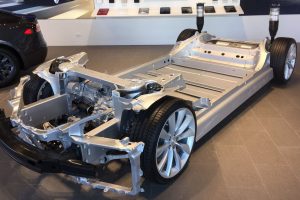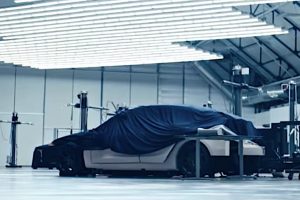A million-mile battery, cheaper than ever, with production at high speed. It’s a special edition Musk Reads #200, featuring an Inverse interview with “The Limiting Factor” host Jordan Giesige.
Key Quote
“It’s such a massive improvement that it might land Jeff Dahn a Nobel Prize at some point.”
- Jordan Giesige, host of YouTube channel “The Limiting Factor.” Giesige has experience in both physical factory work and office-based intellectual property roles. His channel, which builds on these experiences, offers a deep dive into the roadblocks that technology hits and how to move past them – namely, the battery that powers practically everything.
What You Need To Know
- Tesla has been working on new battery technologies for several years. These efforts are expected to culminate on Battery Day, set to take place on September 22.
- Battery advancements help to move the “spider diagram” in one or two areas: energy density, charge and discharge rate, durability, cycling ability, cost, ease of manufacture. Giesige says Tesla’s Battery Day will likely show “an improvement in every aspect of the spider diagram.”
- This could lead to cheaper electric cars, better grid-based storage, and all-new vehicles – perhaps even an electric jet.
The Deep Dive
Tesla is building a more advanced battery that could improve its electric vehicles, boost the grid-based storage used to provide a constant source of renewable energy, and even create new ways to get around.
Battery Day is expected to explain these advancements in detail. The livestream event is scheduled to take place immediately after Tesla’s annual stockholder meeting, which is slated for Tuesday, September 22 at 1:30 p.m. Pacific time. In January 2020, Musk described the event as “one of the most exciting days in Tesla’s history.”
Giesige, who spoke with Inverse in a May phone interview and via email in September, explains that there are two factors at play with Tesla’s research. The first is Jeff Dahn, recognized as one of the pioneers of the lithium-ion battery. Dahn started a five-year research partnership with Tesla in 2016. One of his biggest breakthroughs is to develop equipment that can identify battery inefficiencies.
“A battery cell is a closed system,” Giesige says. “So any inefficiencies you have in that system, even if it’s a tiny inefficiency of 0.001 percent, that means your battery’s going to degrade rapidly.”
Dahn has gradually identified factors that can degrade a battery and worked to reduce them. He published a research paper in September 2019 in the Journal of the Electrochemical Society detailing a battery that can last for 1 million miles. This compares to the Tesla Model 3, which aims for 70 percent battery retention over eight years or 120,000 miles. A million-mile battery, Giesige argues, could boost the resale value of Tesla’s vehicles.
The second factor is Maxwell Technologies. Tesla bought the firm in February 2019 for $218 million.
“That’s a big kettle of fish,” Giesige says.
The firm is working on what’s called dry battery electrode technology. With a regular battery, the manufacturer applies a wet slurry to the electrode foil and then uses hundreds of meters of drying lines to evaporate the material. Dry battery electrode, as the name implies, skips this process, speeding up manufacturing.
The technology also stops the battery from degrading so fast, as the liquid solvent isn’t being put into the battery. That means better performance over time, reduced heat, and the ability to store more active material. That, in turn, means greater energy density.
A “dry battery electrode” is not the same as a solid state battery, another term that occasionally crops up in these discussions. In the case of a liquid electrolyte, the goal is to move an ion through a liquid. For a solid state battery, the goal is to get the ion to tunnel through a solid material. Proponents of the technology claim it could offer big benefits like moving away from flammable designs, but Giesige explains that, so far, it’s failed to demonstrate something that could move the “spider diagram” in all directions.
“Solid state, if they can ever get it right, is very promising, but so far, nobody has been able to create a solid electrolyte that can do everything well the same way that a liquid electrolyte can,” Giesige says.
Tesla’s technology could offer those improvements in every aspect of the “spider diagram.” Where most breakthrough technologies improve in one or two areas, Tesla’s technology could improve by about 20 or 30 percent in almost every area.
“It’s an amazing achievement…such a massive improvement that it might land Jeff Dahn a Nobel Prize at some point,” Giesige says. He notes the committee recognized three lithium-ion pioneers last year: John Goodenough, M. Stanley Whittingham, and Akira Yoshino. Dahn’s achievements, Giesige argues, are “at least as important as the lithium-ion cell itself.”
Previous rumors suggested the firm plans to unveil their new approach on Battery Day, demonstrating the technology by rolling out a vehicle sporting the new battery. Giesige is unsure about what a release schedule could look like, but speaking in May when Battery Day was rumored for June, he suggested a launch in the same year could make sense.
“Otherwise, they’re going to get the Osborne effect,” Giesige says, a reference to how announcing a product too early can result in sales dropping as consumers wait for the next big thing.
But Tesla is unlikely to immediately switch all of its battery production over to its new battery research. Giesige says “one theory” he has is that “over the past year, they’ve been slowly rolling in these improvements into the chemistry.” This, he says, would explain improvements in driving range for the Tesla Model S and Model X.
The new cells could offer far cheaper prices than ever before. Giesige claims Tesla is at around $100 per kilowatt-hour at the cell level, and likely more at $150 per kilowatt-hour at the pack level. Giesige argues that with improvements over time, Tesla could start thinking about offering a $25,000 car when prices reach $70 to $80 per kilowatt-hour.
Catching up with Inverse in September, Giesige says he didn’t emphasize the speed and cost enough. Tesla’s improvements in manufacturing, as seen with projects like the Model Y’s giant casting machine, help drive down the costs and improve the speed of manufacturing. It’s likely to do the same thing with batteries.
“In other words, Tesla has the potential to release the lowest cost nickel-based battery chemistry in the world that’s also the highest energy density and cobalt free,” Giesige says. “We may not see all of these in version one of Tesla’s battery manufacturing line, but if we do, it will be the crown jewel in accelerating the world’s transition to sustainable energy. It would also eventually propel Tesla to rank as the most valuable company in the world.”
Beyond financial results, the breakthroughs could push Tesla to new technological highs. Giesige believes the gap between Tesla and other automakers will widen to the extent that “most of the other auto companies are going to go out of business.”
Tesla’s breakthrough could also lead to new kinds of vehicles. Giesige says Tesla is likely focusing on the vehicles where it could have the biggest effect to start with, gradually moving out to cover more ambitious niches.
That might include an electric vertical takeoff and landing vehicle. Tesla could start small, perhaps with a short-haul flying machine, before building up to bigger projects. Musk has proposed an electric jet a few times. In August 2020, Musk claimed it would require a battery with 400 watt-hours per kilogram of density to enable it to fly. Current electric vehicles are around 250 watt-hours per kilogram, Musk said in 2018. Mass production of a battery that reaches 400 watt-hours per kilogram is three to four years away, he wrote in August.
Tesla’s expansion may involve what Giesige describes as “new forms of transport that we hadn’t even thought of before.” While Tesla is a car company today with a smaller energy business, its battery improvements might help fuel unimaginable new ways to get from A to B – all with zero emissions.
Original Publication by Mike Brown at Inverse.
Want to buy a Tesla Model 3, Model Y, Model S, or Model X? Feel free to use my referral code to get some free Supercharging miles with your purchase: http://ts.la/guanyu3423
You can also get a $100 discount on Tesla Solar with that code. Let’s help accelerate the advent of a sustainable future.





